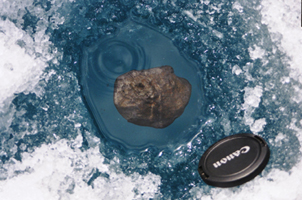The Tagish Meteorite was probably about 5 meters across before it entered the Earth's atmosphere. It broke apart before landing on the icy lake. Before the rising temperatures of spring melted the ice on the lake, over 500 meteorite fragments were found, 410 fragments were documented and about 200 fragments were recovered. One of the meteorite fragments appears here in the ice of Tagish Lake. The camera lense cap was placed next to the meteorite fragment for size comparison purposes.
Click on image for full size
Image courtesy of the University of Western Ontario and the University of Calgary
A Look at the Solar System's Past - the Tagish Meteorite
News story originally written on September 24, 2001
On January 18, 2000, a bright fireball streaked through the skies of northern Canada as a meteorite entered
the atmosphere and fell to
Earth. The meteorite eventually came to rest on the surface of a frozen
lake (Tagish Lake, in British Columbia). In addition to providing those who saw it fall with an exciting show, the meteorite has turned out to be one of the most interesting meteorites ever found.
The Tagish Lake Meteorite is one of a rare class of carbon-rich, charcoal-like meteorites called "carbonaceous chondrites". This class of meteorites is made up of the same dust and gases from which the solar system formed. By studying the chemical composition of these meteorites, scientists can study what the chemical composition of the early solar system was like.
Scientists are especially interested in the Tagish Lake Meteorite because recent studies have shown that the molecules found inside this meteorite are much simpler than those found in other meteorites in this class. Other meteorites have had a much more complex mixture of molecules, but the Tagish Lake samples contained mostly molecular carbon and pockets of helium and argon (two gases that would have been found in the gas and dust clouds that the solar system formed from).
Because the Tagish Lake Meteorite is so primitive chemically, it gives scientists a better understanding of what the early composition of the solar system was like. In a way, then, it's a little like being given a picture of the solar system as a baby, and being able to understand a little better what it was like when it was young!
You might also be interested in:
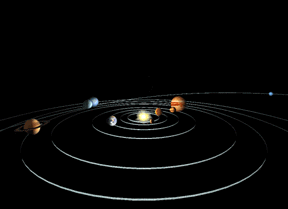
Scientists believe that the solar system was formed when a cloud of gas and dust in space was disturbed, maybe by the explosion of a nearby star (called a supernova). This explosion made waves in space
...more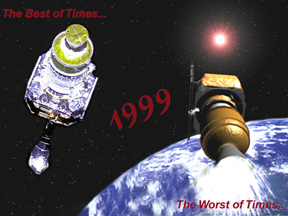
It was another exciting and frustrating year for the space science program. It seemed that every step forward led to one backwards. Either way, NASA led the way to a great century of discovery. Unfortunately,
...more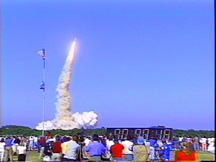
The Space Shuttle Discovery lifted off from Kennedy Space Center on October 29th at 2:19 p.m. EST. The weather was great as Discovery took 8 1/2 minutes to reach orbit. This was the United States' 123rd
...more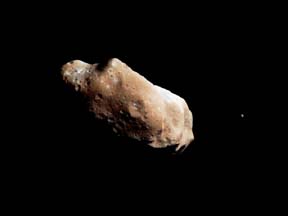
A moon was discovered orbiting the asteroid, Eugenia. This is only the second time in history that a satellite has been seen circling an asteroid. A special mirror allowed scientists to find the moon
...more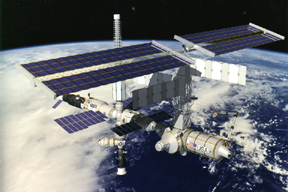
Will Russia ever put the service module for the International Space Station in space? NASA officials want an answer from the Russian government. The necessary service module is currently waiting to be
...more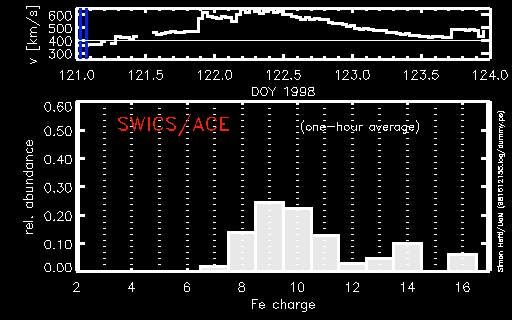
A coronal mass ejection (CME) happened on the Sun early last month. The material that was thrown out from this explosion passed the ACE spacecraft. The SWICS instrument on ACE has produced a new and very
...more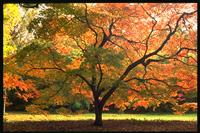
J.S. Maini of the Canadian Forest Service called forests the "heart and lungs of the world." This is because forests filter air and water pollution, absorb carbon dioxide, release oxygen, and maintain
...more


